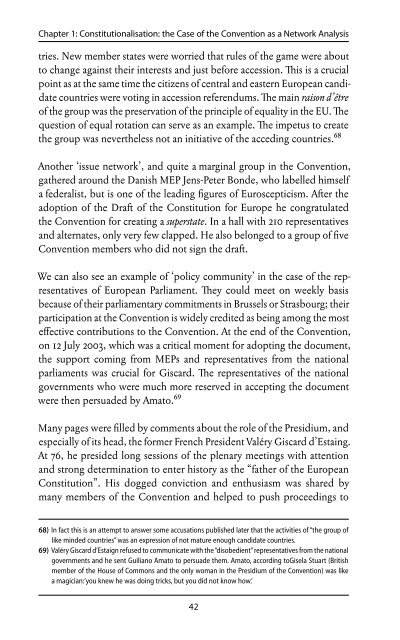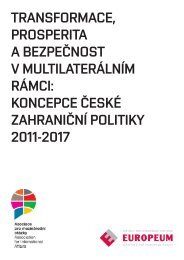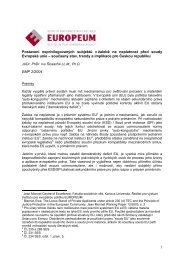eu constitutionalisation - EUROPEUM Institute for European Policy
eu constitutionalisation - EUROPEUM Institute for European Policy
eu constitutionalisation - EUROPEUM Institute for European Policy
Create successful ePaper yourself
Turn your PDF publications into a flip-book with our unique Google optimized e-Paper software.
Chapter 1: Constitutionalisation: the Case of the Convention as a Network Analysistries. New member states were worried that rules of the game were aboutto change against their interests and just be<strong>for</strong>e accession. This is a crucialpoint as at the same time the citizens of central and eastern <strong>European</strong> candidatecountries were voting in accession referendums. The main raison d’êtreof the group was the preservation of the principle of equality in the EU. Thequestion of equal rotation can serve as an example. The impetus to createthe group was nevertheless not an initiative of the acceding countries.⁶⁸Another ‘issue network’, and quite a marginal group in the Convention,gathered around the Danish MEP Jens-Peter Bonde, who labelled himselfa federalist, but is one of the leading figures of Euroscepticism. After theadoption of the Draft of the Constitution <strong>for</strong> Europe he congratulatedthe Convention <strong>for</strong> creating a superstate. In a hall with 210 representativesand alternates, only very few clapped. He also belonged to a group of fiveConvention members who did not sign the draft.We can also see an example of ‘policy community’ in the case of the representativesof <strong>European</strong> Parliament. They could meet on weekly basisbecause of their parliamentary commitments in Brussels or Strasbourg; theirparticipation at the Convention is widely credited as being among the mosteffective contributions to the Convention. At the end of the Convention,on 12 July 2003, which was a critical moment <strong>for</strong> adopting the document,the support coming from MEPs and representatives from the nationalparliaments was crucial <strong>for</strong> Giscard. The representatives of the nationalgovernments who were much more reserved in accepting the documentwere then persuaded by Amato.⁶⁹Many pages were filled by comments about the role of the Presidium, andespecially of its head, the <strong>for</strong>mer French President Valéry Giscard d’Estaing.At 76, he presided long sessions of the plenary meetings with attentionand strong determination to enter history as the “father of the <strong>European</strong>Constitution”. His dogged conviction and enthusiasm was shared bymany members of the Convention and helped to push proceedings to68) In fact this is an attempt to answer some accusations published later that the activities of “the group oflike minded countries” was an expression of not mature enough candidate countries.69) Valéry Giscard d’Estaign refused to communicate with the “disobedient” representatives from the nationalgovernments and he sent Guiliano Amato to persuade them. Amato, according toGisela Stuart (Britishmember of the House of Commons and the only woman in the Presidium of the Convention) was likea magician:‘you knew he was doing tricks, but you did not know how.’Chapter 1: Constitutionalisation: the Case of the Convention as a Network Analysisa conclusion. He managed to create many networks himself at differentlevels: his role as the President of the Convention’s guiding triumvirate,together with Amato and Dehaene; as head of the 12-member Presidium,his link with the secretariat, and last but not least his bilateral communicationwith the state representatives during the sessions of the Conventionor during his many visits to the member or candidate countries. On onehand Giscard was accused <strong>for</strong> being rather too authoritarian and listeningmore attentively to the representatives of the big countries, but withouthis determination, sometimes endless discussions would not result in thedesired consensus.National delegations as networks?The Case of the Czech representation in the ConventionJo Shaw wrote: “One clearly important innovation (…) which createsa very different feel to the Convention as compared to the IGC is thepresence of national opposition parties through the medium of nationalparliamentary representatives and <strong>European</strong> parliamentary representatives,sitting in the same debating chamber and round the same negotiatingtables as national government representatives. This brakes downthe sense of the unitary ‘national’ interests.”⁷⁰ The division in the Czechpolitical scene as well as in the Czech society found its expression also inthe participation at the Convention. The representation at the Conventionwas organized according to political affiliation. The representative of theCzech Government, Jan Kavan, was a <strong>for</strong>mer minister of <strong>for</strong>eign affairsand member of the Social Democratic party (ČSSD). In summer 2002,after national elections, he was replaced by his alternate Jan Kohout,state secretary and first deputy minister of <strong>for</strong>eign affairs responsible <strong>for</strong><strong>European</strong> matters (also ČSSD). The House of Deputies of the Parliament(the lower chamber) appointed as its representative in the Convention JanZahradil, member of the main opposition party ODS (Civic DemocraticParty) and shadow minister of <strong>for</strong>eign affairs. The Senate was representedby Josef Zieleniec, <strong>for</strong>mer minister of <strong>for</strong>eign affairs, then affiliated to theright-of-centre Four-party Coalition.⁷¹70) SHAW (2003), p. 5471) The alternate <strong>for</strong> Jan Kohout was Lenka A.Rovná, Professor at Charles University, no party. The alternate<strong>for</strong> Jan Zahradil was Petr Nečas, MP from ODS. The Alternate <strong>for</strong> Josef Zieleniec, Senator Kroupa, is fromKDU-ČSL (Christian democrats).4243








